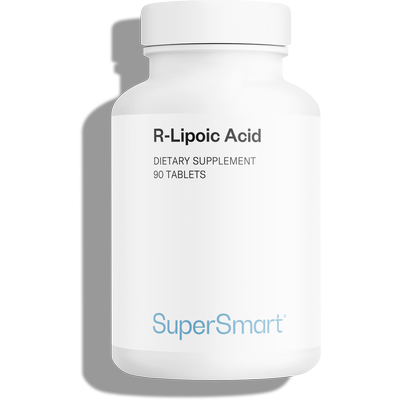News on alpha-lipoic acid: the king of the antioxidants and ageing’s arch enemy
You’re interested enough in nutrition to know that antioxidants are essential for good health. You know, for example, that fruits and vegetables contain large amounts of antioxidants and that they help reduce the effects of ageing. You’re no doubt aware of the carotenoids, of vitamins C and E, selenium, and maybe even the flavonoids …
But would you be able to explain their precise roles within the body? Could you talk about the ‘king’ of the antioxidants, the crème de la crème, the one that regenerates all the others? Do you know in which situations they are indispensable and when to take them?
In this article, we give you the definitive low-down on antioxidants - what purpose they serve, how they work and which are the most powerful.
Extracting energy from food is the origin of everything
In order to perform the essential functions of life, such as moving, breathing and transporting substances around the body, our cells need to obtain energy from external sources. We get this energy from food, and more specifically, food that contains protein, fats and carbohydrates. The living organisms that produced these nutrients will have used energy themselves, and this energy is still there! It may change forms but energy is never lost. When your body converts the chemical energy contained in a steak, it is the energy used by the cow to produce its muscles. When you eat an apple, you’re drawing on the energy used by the apple tree to produce one of its fruits. Animals obtain their energy by eating other animals or plants, while plants capture and use energy from the sun. In the vast majority of cases, therefore, there’s no need to eat living beings! They should be allowed to carry on living because, if you think about it, all the energy circulating in the world comes from the sun.
Getting back to the three nutrient groups which maintain life, there’s a considerable amount of energy in fats, protein and sugars, but it still needs to be converted! If we simply broke open these molecules, a lot of energy would be released but in a way that would be completely uncontrolled, and in a highly-dangerous and explosive form. No animal could successfully use energy this way – just as an explosion in a fuel tank would be unable to power a car.
Animals have thus developed a complex system in which these nutrients are ‘burned’ in a series of steps, with the aid of several additional ‘ingredients’, notably the oxygen we draw from the air we breathe. In ensuring the original molecules are converted into increasingly low-energy ones, this system releases energy gradually, which means it can be stored in a new form called ATP. ATP is a small energy molecule which is easily used by the body to carry out all its energy-requiring activities, from synthesising proteins, to transporting substances across cell membranes, changing the shape of a cell and even blinking. Suffice to say that ATP is a fundamental molecule for the body. In less than a minute, one muscle cell uses almost 10 million molecules of ATP!
Generation of ROS, oxidising compounds that accelerate ageing
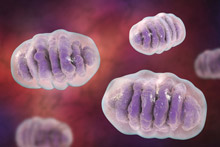
These complex conversions take place in our cells, mostly in small powerhouses called ‘mitochondria’ – more-or-less permeable structures found in almost all our cells. They culminate in the production of ATP, as well as in the rejection of ‘clean’ waste products – so-called because they’re not toxic to the body: carbon dioxide (CO2) and water. Unfortunately, they’re not the only waste products created as part of the process: during the various stages, molecules are formed which are particularly toxic to cells: reactive oxygen species (ROS). These highly-unstable elements may escape from the mitochondria and react with oxygen to form even more toxic compounds. They have a compelling need to ‘steal’ electrons from other molecules in order to gain stability and will attack any molecule in their path in order to do so. Production of ROS is inevitable. It’s the price paid for such a super-efficient energy conversion system (around 34% of energy is captured from nutrients, whereas a car engine, for example, barely manages 25% from its fuel). While the body is brilliant at exploiting energy using oxygen, small amounts of these toxic molecules are produced at the same time which can be harmful to the body over the long term. It’s a fair compromise.
To prevent these molecules from damaging important compounds in the powerhouses, the cells or extra-cellular elements (such as proteins), the body has established an original stratagem: it dispatches substances to ‘the front’ that allow themselves to be broken down by the ROS, donating the elements of stability they crave. These are the famous antioxidants. They are rather like soldiers in frontline positions who sacrifice themselves for the greater good of their country. They take the ‘hit’ so others don’t have to. As a result of their actions, the ROS do not ‘steal’ structural elements from vital molecules.
Antioxidants versus ROS: a fair fight – at least for a while
Normally, ROS are present in our cells at manageable levels. The body produces sufficient quantities of antioxidants to minimise any damage. It also uses the antioxidants it finds in ingested food, particularly in fruits and vegetables. And yes, just like us, plants produce their own ‘soldiers’ to combat ROS and logically enough, these compounds are present in the parts of plants that we consume. In fact, they produce a lot more of them than we do! In contrast to animals, plants need to be exposed to the sun’s rays as much as possible in order to produce energy. But we know that UV radiation generates a large amount of ROS (this is why people who spend too much time in the sun have an increased risk of skin cancer!). In addition, plants produce pure oxygen during photosynthesis, which leads to increased production of these unstable molecules. They protect themselves by producing a powerful assortment of antioxidants.
The body thus uses two types of ‘soldier’ to combat ROS: endogenous antioxidants (those it makes itself) and exogenous antioxidants (those present in food). And each type has its own ‘stomping ground’: some, such as vitamin E, are ‘specially trained’ to exist in lipid environments such as cell membranes, while others, such as vitamin C, do so in aqueous milieu such as cytoplasm.
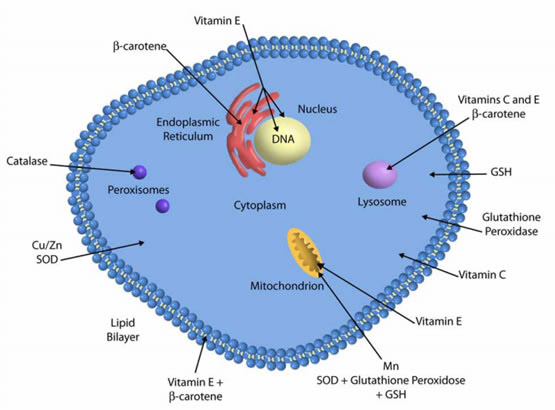
The battle between ROS and antioxidants starts as soon as fertilisation takes place and an embryo forms. And it lasts … a lifetime. For a significant period, at least 20 years, they’re evenly matched. The antioxidants neutralise the ROS, important compounds are rarely attacked and the body functions optimally. ROS are even ‘used’ on a regular basis by the body to communicate or to fight foreign elements.
Oxidative stress: when ROS gain the upper hand and seriously threaten our health
It’s after the age of 30 that things start to get complicated. From this point on (though it can be earlier or later), ROS start to gain an advantage. A number of environmental factors such as excess weight, ingestion of toxins (cigarette smoke, pesticides heavy metals, etc), exposure to atmospheric pollution, microbial infections, UV rays, chronic inflammation and stress, gradually increase ROS levels in the body. If these factors are temporary, the body will restore adequate production of antioxidants and maintain the status quo. But if they persist over time, the balance is disrupted. This is when the body needs more exogenous antioxidants from the diet. Its own production has reached its limit and the only way of ‘swelling the numbers of troops’ is to consume more ‘ready-formed’ antioxidants. Unfortunately, however, the reverse is more often the case: our consumption of antioxidants from fruit, vegetables and other plant sources is simply not up the challenge.
The continuing superiority of the ROS subsequently and rapidly produces irreversible damage to many biological molecules, which over time, leads to loss of function (1).
Proteins, the prime targets of ROS
In 50-70% of ROS attacks, proteins are the prime targets, with consequences of varying severity (2). ROS generally break down protein side-chains, with a preference for sulphur-containing amino acids (cysteine, methionine), basic amino acids (arginine, histidine, lysine) and aromatic amino acids (phenylalanine, tyrosine, tryptophan). Most of the time, this damage is short-lived because the body can make new ones to replace them, but it temporarily disrupts the functioning of numerous systems (3), including the antioxidant system itself! More seriously, what can also happen is that the damaged proteins cannot be eliminated or replaced.

Let’s take the example of atherosclerosis, a chronic inflammatory process which results in the formation of plaques in the large and medium-sized arteries. To start with, ROS attack proteins circulating in the blood called LDL and VLDL. These proteins transport cholesterol to every cell in the body. When damaged by ROS, they generate pro-inflammatory messengers, thus posing a serious threat to the immune system. Specialist cells called macrophages then act to swallow them up and neutralise them. Unfortunately, in people with high levels of LDL and VLDL (usually due to excessive intake of sugar and cholesterol), these specialist cells have a lot of work to do. With so many ROS-damaged LDLs and VLDLs, the macrophages literally have to gorge themselves in order to scavenge them all. So very quickly, they too end up containing astonishing levels of cholesterol - so much so that at certain unstable points in the bloodstream, they get ‘washed up’ on the artery wall’s innermost layer where they form highly dangerous plaques (4). The famous atheromatous plaques.
In other pathological situations, ROS-damaged proteins do not get destroyed by the body and may form aggregates which accumulate in cells and in the extracellular space.
ROS also attack DNA
Unfortunately, ROS are particularly fond of DNA, especially one of its compounds, guanine. But here, it’s quite a different story: DNA is not a molecule than can be easily replaced. There are repair systems, it’s true, but the information responsible for these systems is itself inscribed in the DNA. Long-term damage to DNA by ROS thus disrupts numerous physiological mechanisms and plays direct and indirect roles in the development of cancer and ageing. Over time, DNA repair systems become defective, resulting in yet more mutations and malfunctions. No system is spared once DNA is affected.
This chain of destruction has been demonstrated in the ageing process as well as in almost all chronic diseases. It is the direct cause of several forms of cancer, of atherosclerosis, and probably, of Alzheimer’s disease and diabetes.
Attacks on lipid membranes
Our cell membranes are also key targets for ROS. They contain fatty acids essential for our health: polyunsaturated fats (including some of the omega-3 fatty acids). It is these fatty acids which are of particular interest to ROS. They are responsible for the suppleness of our membranes, a property vital for ensuring healthy nerve transmission and preventing cognitive decline. Without them, membranes become rigid, significantly impairing cells. Some even end up dying.
ROS convert these highly-beneficial fatty acids into new products that are harmful to several biological activities (5). This is called lipid peroxidation. It is the progressive destruction of cell membranes, and it continues all the time there are no defensive elements to stop it (like a domino effect). Defence of the membranes is the main role of one of the body’s endogenous antioxidants: glutathione peroxidase.
The exogenous antioxidants at our disposal: from the least active to the most effective
You can see now that when our endogenous antioxidants are in short supply, exogenous antioxidants from the diet take on a crucial role. That’s why it’s important for everyone, especially those over 30, to eat at least five portions of fruit and vegetables a day (in fact, you need much more).
While there are a great many dietary antioxidants, three in particular stand out.
Vitamin C
Most mammals are able to produce vitamin C in the liver or kidneys, but not humans. We have to obtain it from the diet (at least 100mg a day). Vitamin C is very effective at trapping ROS. It stops lipid peroxidation by regenerating another antioxidant capable of functioning in a lipid milieu: vitamin E.
Vitamin E
Vitamin E is actually an umbrella term for a collection of very similar antioxidant molecules - tocopherols and tocotrienols. They have an affinity for lipid milieux and are thus able to penetrate cell membranes. Alpha-tocopherol is the most abundant (around 10mg a day from the diet from certain vegetable oils and nuts) but gamma-tocopherol appears to be the most effective (it’s found in sesame oil).
Alpha lipoic acid, the most effective of all
You may not be aware of it, but it’s without doubt the most effective antioxidant of all. It is produced naturally by the body but is also found in the diet (there are small amounts in green leafy vegetables like spinach
.Here are four properties which make it truly exceptional:
- Its huge versatility. It works in both aqueous and lipid environments, unlike vitamin E (lipid only) and vitamin C (aqueous only). This is why it’s so often referred to as the universal antioxidant.
- Its regenerative power. It is capable of regenerating the other antioxidants after they have neutralised ROS. It thus extends the life and efficacy of vitamins E and C and glutathione (and it promotes production of the latter).
- Its chelating effect. It also has the invaluable ability to trap toxic metals such as arsenic, cadmium and mercury (6-7).
- Its reparative power. Not only does it combat ROS and regenerate ‘soldiers killed in combat’, alpha-lipoic acid is also able to repair some of the oxidative damage inflicted on molecules, notably proteins. This is a particularly important property where proteins are concerned as their rate of replacement is very low like myoglobin (8).
A healthy 20 year-old body produces enough lipoic acid to meet its needs. But this is definitely not the case for a more ‘mature’ body, especially if it’s affected by a chronic disease, diabetes, cirrhosis or atherosclerosis (9).
Scientists are currently engaged in an increasing number of clinical trials to understand the extent of alpha-lipoic acid’s powers. We already know it combats oxidative stress, the imbalance in which ROS have the upper hand. It is remarkably effective at boosting the ‘troops’, the effects of which fluctuate dangerously. And it is therefore beneficial for any illness associated with oxidative stress. One study demonstrated the positive effects of supplementing with alpha-lipoic acid for age-related hearing loss (10).
But the latest studies show it can do much more than that.
Alpha-lipoic acid’s powers against ageing: telomerase and the circadian clock
Several decades ago, scientists discovered that our chromosomes, the elements that carry our genetic information, regularly shorten as we age. To protect our genes from paying the price for this, it seems nature arranged things so that the tips of our chromosomes would carry completely redundant DNA sequences; in this way, even when they shortened, no gene would be lost. Unfortunately, however, these redundant sequences are not infinite, and sooner or later, a gene does indeed get wiped out, taking with it precious genetic information. From this point on, as our chromosomes continue shortening, numerous genes disappear, causing major dysfunction in cells and in the whole body. When cells reach this stage, the majority of them ‘commit suicide’ to avoid a catastrophe. This is another element of the ageing process …
In actual fact, there is an enzyme which adds new DNA sequences to the tips and prevents this shortening, but it is only expressed in certain cells, notably embryonic cells. This enzyme is called telomerase. In 2015, scientists showed that administration of alpha-lipoic acid stimulated activity of this enzyme, with positive effects observed in animals affected by atherosclerosis (11).
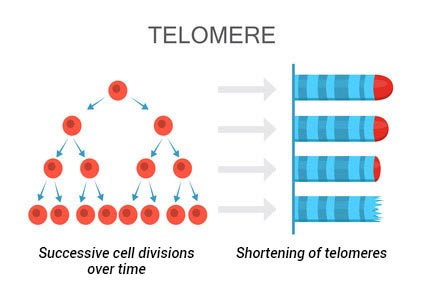
And that’s not all! The researchers also demonstrated that lipoic acid helped maintain normal circadian rhythms (12). We know that this ‘biological clock’, which is disrupted by ageing, influences countless biological functions such as stress resistance, cardiac function, hormonal balance, muscle performance, glucose metabolism … “In animals supplemented with lipoic acid, we observed improved cognitive ability and expression of around a hundred genes associated with detoxification and antioxidation comparable to that of younger animals”, enthused study author Professor Tory Hagen. “The more we improve our understanding of the biological clock, the more we find that it’s involved in very many aspects of life”, he continued. “Circadian rhythms affect the fluctuation of many critical biological processes: if lipoic acid can help resynchronise them, it could confer a significant advantage.”
Alpha-lipoic acid and antioxidants: the research continues
Researchers are continuing to explore the as yet undiscovered powers of alpha-lipoic acid but, as with all antioxidants, this is tricky. The benefits of these compounds lie in their ability to prevent the development of diseases associated with oxidative stress and to slow down the ageing process. But it is difficult to measure these effects in clinical trials which generally only last a few months. Supplementation over two, five or even ten years may have prevented the development of a disease, slowed down certain signs of ageing or delayed the onset of hearing problems, but how can you prove it when these health problems have been prevented? And how can you prove that they’ve been prevented thanks to the supplementation?
Indeed, it’s in some ways the same problem researchers face in proving the long-term toxicity of certain products such as pesticides. These work in precisely the opposite way: they increase levels of ROS and accelerate the development of cancers and ageing. As more than 20 years can pass before effects show, it can take scientists decades to prove associations between products and health risks. Making causal links relies primarily on observational studies and laboratory research: clinical trials are of no use in evaluating the risks of such substances (after all, no-one would volunteer to take part in a trial where they had to take pesticide supplements for 30 years, would they?).
To get back to alpha-lipoic acid, clinical trials are better at demonstrating effects in already serious situations when ROS are omnipresent, such as in diabetes. They also show it leads to clear reductions in ROS levels in plasma and increases in antioxidant levels (13). For anything else, we’ll have to rely on the already well-supplied route of observational, in vitro and animal studies.
How do you go about choosing an alpha-lipoic acid supplement?
There’s no way round it: alpha-lipoic acid supplements have to be produced in a laboratory. The process results in the creation of a blend of two forms of lipoic acid – the R and S forms. The R form is exactly the same molecule as that produced by the body. The S form, however, is just a poor copy and appears to be completely inactive.
Most of the alpha-lipoic supplements on the market contain both forms as it’s quite a costly process to separate them. So you need to be careful: if the label only says the product contains 200mg of alpha-lipoic acid without any other details, it’s probably safe to assume that it contains equal amounts of both forms, which effectively means only 100mg of alpha-lipoic acid. Even though the S form appears to be harmless, it’s a molecule that serves no purpose in your body. So if you have the choice, opt for supplements containing just the R form such as R-Lipoic Acid 100mg.
Also go for supplements with a lower dose per capsule: alpha-lipoic acid’s life in the body is quite short (14), so it’s better to take small amounts in several doses. The oral doses used in scientific studies are between 100-200mg, taken three times a day. In studies demonstrating benefits (15-21), several weeks of treatment were necessary before effects were felt.
It’s also important to take it in between meals as its bioavailability is significantly reduced by other nutrients and micronutrients. If it doesn’t have to compete with them, it can monopolise two main transporters in order to cross the intestinal barrier and reach the various tissues (22.
The final point to be aware of is that alpha-lipoic acid is very sensitive to heat, humidity and light: it’s therefore essential to store it
in a cool, dry place.Summary of key points
- When energy is produced from food and oxygen in the air, it also generates compounds toxic to the body called ROS.
- These reactive compounds are kept under control by antioxidants, both endogenous (those produced by the body) and exogenous (those provided by the diet or supplementation).
- During the course of ageing and in parallel with many diseases, ROS gain the upper hand and damage a number of essential molecules such as proteins, lipids and even DNA.
- Alpha-lipoic acid is the ultimate universal antioxidant: it is both produced by the body and is found in certain foods. A powerful anti-mutagen and regenerator of many other antioxidants, it also acts against ageing.
A suitable dose is three capsules of 100mg of R-lipoic acid a day, taken in between meals.
Recipe foreffective and long-lasting energy production
Main ingredients:
- Foods high in carbohydrates, protein and lipids (providing around 2000-3000 calories a day).
- Oxygen (around 12,000 litres of air a day).
- Vitamin B3 (which supports production of NAD, an important intermediary).
- Co-enzyme Q10 (an intermediary found primarily in meat and fish).
Residues and waste-products produced by the system:
- Carbon dioxide (CO2).
- Water.
- ROS – pro-oxidant toxins.
Tips for success:
- A healthy intestinal wall for effective nutrient absorption (carbohydrates, protein, fats) and secondary micronutrients.
- Antioxidant supplementation (especially alpha-lipoic acid) and a diet rich in raw, plant-source foods.
- Avoiding any additional sources of ROS such as smoking, pesticides, pollution, unsafe exposure to the sun (unprotected skin), continued exposure to noise, etc.
References
- Carrière A, Galinier A, Fernandez Y, et al. Les espèces actives de l’oxygène : le yin et le yang de la mitochondrie. Med Sci (Paris) 2006 ; 22 : 47-53.
- Davies KJ. Protein damage and degradation by oxygen radicals. I. General aspects. J Biol Chem 1987 ; 262 : 9895-901
- Finkel T. Redox-dependent signal transduction. FEBS Lett 2000 ; 476 : 52-4.
- Nakajima K, Nakano T, Tanaka A.— The oxidative modification hypothesis of atherosclerosis : The comparison of atherogenic effects on oxidized LDL and remnant lipoproteins in plasma. Clin Chim Acta, 2006, 367, 36-47.
- Murphy RC. Free radical-induced oxidation of glycerophosphocholine lipids and formation of biologically active products. Adv Exp Med Biol 1996 ; 416 : 51-8.
- Biewenga GP, Haenen GR, Bast A. The pharmacology of the antioxidant lipoic acid. General pharmacology. 1997;29(3):315-31. Epub 1997/09/01
- Goraca A, Huk-Kolega H, Piechota A, Kleniewska P, Ciejka E, Skibska B. Lipoic acid - biological activity and therapeutic potential. Pharmacological reports : PR. 2011;63(4):849-58. Epub 2011/10/18.
- Packer L, Witt EH, Tritschler HJ. alpha-Lipoic acid as a biological antioxidant. Free radical biology & medicine. 1995;19(2):227-50. Epub 1995/08/01.
- Kagan VE, Shvedova A, Serbinova E, et al. Dihydrolipoic acid—a universal antioxidant both in the membrane and in the aqueous phase. Reduction of peroxyl, ascorbyl, and chromanoxyl radicals. Biochem Pharmacol. 1992;44:1637-1649.
- Seidman MD, Khan MJ, Bai U, et al. Biologic activity of mitochondrial metabolites on aging and age-related hearing loss. Am J Otol.2000;21:161-167.
- Shiqin Xiong, Nikolay Patrushev, Farshad Forouzandeh, Lula Hilenski, R. Wayne Alexander. PGC-1α Modulates Telomere Function and DNA Damage in Protecting against Aging-Related Chronic Diseases. Cell Reports, 2015; DOI: 10.1016/j.celrep.2015.07.047
- Oregon State University. "Lipoic Acid Explored As Anti-aging Compound." ScienceDaily. ScienceDaily, 18 May 2007.
- Mantovani G, Maccio A, Madeddu C, Mura L, Massa E, Gramignano G, et al. Reactive oxygen species, antioxidant mechanisms, and serum cytokine levels in cancer patients: impact of an antioxidant treatment. Journal of environmental pathology, toxicology and oncology : official organ of the International Society for Environmental Toxicology and Cancer. 2003;22(1):17-28. Epub 2003/04/08.
- Breithaupt-Grogler, Dose-proportionality of oral thioctic acid--coincidence of assessments via pooled plasma and individual data. Eur J Pharm Sci. 1999 Apr;8(1):57-65.
- Jacob S, Henriksen EJ, Schiemann AL, et al. Enhancement of glucose disposal in patients with type 2 diabetes by alpha-lipoic acid.Arzneimittelforschung. 1995;45:872-874.
- Kawabata T, Packer L. Alpha-lipoate can protect against glycation of serum albumin, but not low density lipoprotein. Biochem Biophys Res Commun. 1994;203:99-104.
- Nagamatsu M, Nickander KK, Schmelzer JD, et al. Lipoic acid improves nerve blood flow, reduces oxidative stress, and improves distal nerve conduction in experimental diabetic neuropathy. Diabetes Care. 1995;18:1160-1167.
- Suzuki YJ, Tsuchiya M, Packer L. Lipoate prevents glucose-induced protein modifications. Free Radic Res Commun. 1992;17:211-217
- Jacob S, Ruus P, Hermann R, et al. Oral administration of RAC-alpha-lipoic acid modulates insulin sensitivity in patients with type-2 diabetes mellitus: a placebo-controlled pilot trial. Free Radic Biol Med. 1999;27:309-314.
- Dincer Y, Telci A, Kayali R, Yilmaz IA, et al. Effect Of alpha-Lipoic Acid On Lipid Peroxidation And Anti-Oxidant Enzyme Activities In Diabetic Rats. Clin Exp Pharmacol Physiol. 2002;29:281-284.
- Melhem MF, Craven PA, Liachenko J, et al. Alpha-lipoic acid attenuates hyperglycemia and prevents glomerular mesangial matrix expansion in diabetes. J Am Soc Nephrol. 2002;13:108-116.
- Chng HT, New LS, Neo AH, Goh CW, Browne ER, Chan EC. Distribution study of orally administered lipoic acid in rat brain tissues. Brain Res. 2009 Jan 28;1251:80-6. doi: 0.1016/j.brainres.2008.11.025. Epub 2008 Nov 19.
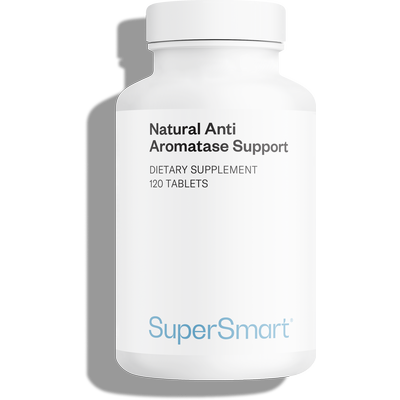
Enhanced formulation with DIM, quercetin and epilobium
www.supersmart.comAll rights reserved
Free
Thank you for visiting our site. Before you go
REGISTER WITHClub SuperSmart
of exclusive benefits:
- Free: our weekly science-based newsletter "Nutranews"
- Special offers for club members only



